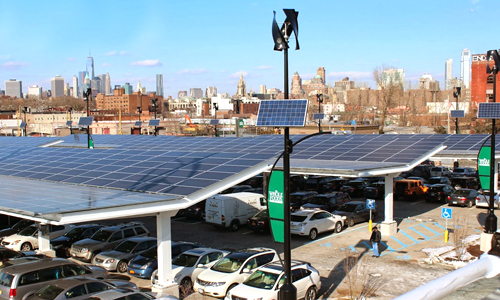Tasmania has a lot going for it in the brave new world of renewable energy, but the Hodgman government is missing in action [14 July 2015 | Peter Boyer]
Jack Gilding is a real achiever in the cause of renewable energy, having led the establishment of Australia’s first community-owned wind farm in Victoria. Now he’s executive officer of the Tasmanian Renewable Energy Alliance.

A “solar carport” at a whole foods business in Brooklyn, USA, featuring electric vehicle chargers, wind turbines and solar panels. PHOTO: Urban Green Energy/Ecowatch
Natural beauty aside, it’s not surprising people like Gilding find Tasmania attractive. With nearly all our electricity coming from hydro, wind and solar power, we’re an ideal proving ground for carbon-free energy systems. But it’s far from smooth sailing.
In a time when overall power charges have risen, Gilding points out that the feed-in tariff – the financial return to rooftop solar owners for putting power into the grid – has dropped three times in two years. It’s now less than a quarter what it was two years ago.
Seven years after enacting its climate action laws, Tasmania continues to depend on power from Victorian brown coal. In 2014-15, says Gilding, we spent $34 million more on this dirty power than we got in revenue from exported hydro and wind power.
This has a back-story: hydro storage was depleted in 2012-14 as we took advantage of the carbon tax windfall by boosting clean power exports. That worked then and it will again; the government is right to support a second Bass Strait power cable.
But losing carbon tax revenue is no reason to penalise solar. Our clear skies make us a better solar platform than hazy northern Europe and much of Japan, China and the United States. The technology is disruptive, but that’s life. We have to make disruption work for us.
Tasmania’s installed hydro gives it a head start to becoming a renewable energy powerhouse. Unlike coal-fired power, hydro can be turned on or off with a flick of a switch, making it a perfect match to fill gaps in intermittent solar and wind generation.
Transport energy in Tasmania is another story. All of it comes from imported oil products, which is a failure on two counts, self-reliance and carbon emissions.
All expert scientific and economic advice, including from the Climate Change Authority, is that to make a fair contribution to the global effort Australia must halve emissions by 2030. If Tasmania takes its share of responsibility, its only real option is to do something about land transport.
Of all possible technologies for powering wheeled vehicles, including hybrid electric and hydrogen fuel cells, the plug-in electric option currently seems most likely to replace fossil fuels. With electric cars, Tasmania’s renewable energy really can deliver emission-free transport.
Electric cars are coming of age. Most major global car makers are investing in the technology, the most advanced of which belongs to the US manufacturer Tesla, with two models in the market and two more in the pipeline. The revolution is poised to happen, probably well within a decade.
Driving the transformation is evolving battery technology with rapidly-improving efficiency, durability and charging speed. The best lithium-ion packs now being produced can drive a car 500 km on a single charge and come with a guaranteed eight-year life.
Electric car prices are dropping, but they’re still much more than internal-combustion equivalents. Against that is a dramatic saving in fuel and maintenance costs with far fewer moving parts to wear out – plus the option of using the cars’ battery power as backup during a home outage.
Australia’s Clean Energy Finance Corporation has just announced a $50 million asset finance agreement with Firstmac, a leading non-bank lender, to help private buyers switch to electric and low-emission vehicles or invest in solar and energy efficient equipment.
With all this going for Tasmania, it’s more than passing strange that the Hodgman government’s two-month-old energy strategy, while mentioning that solar energy and electric cars could have an impact on our energy mix, says nothing about how they might be helped along.
Climate change and renewable energy aren’t favoured conversation topics in government circles in Canberra, that city of blighted hopes, but surely Will Hodgman and his environment minister, Matthew Groom, wouldn’t allow that to silence them down here in Tasmania?
It’s never too late to grasp the nettle. It remains open for Hodgman and Groom to marshal business and community resources and get us moving to an all-renewable future, and if they do I’ll be the first to say thanks. But they need to get a hurry on.
